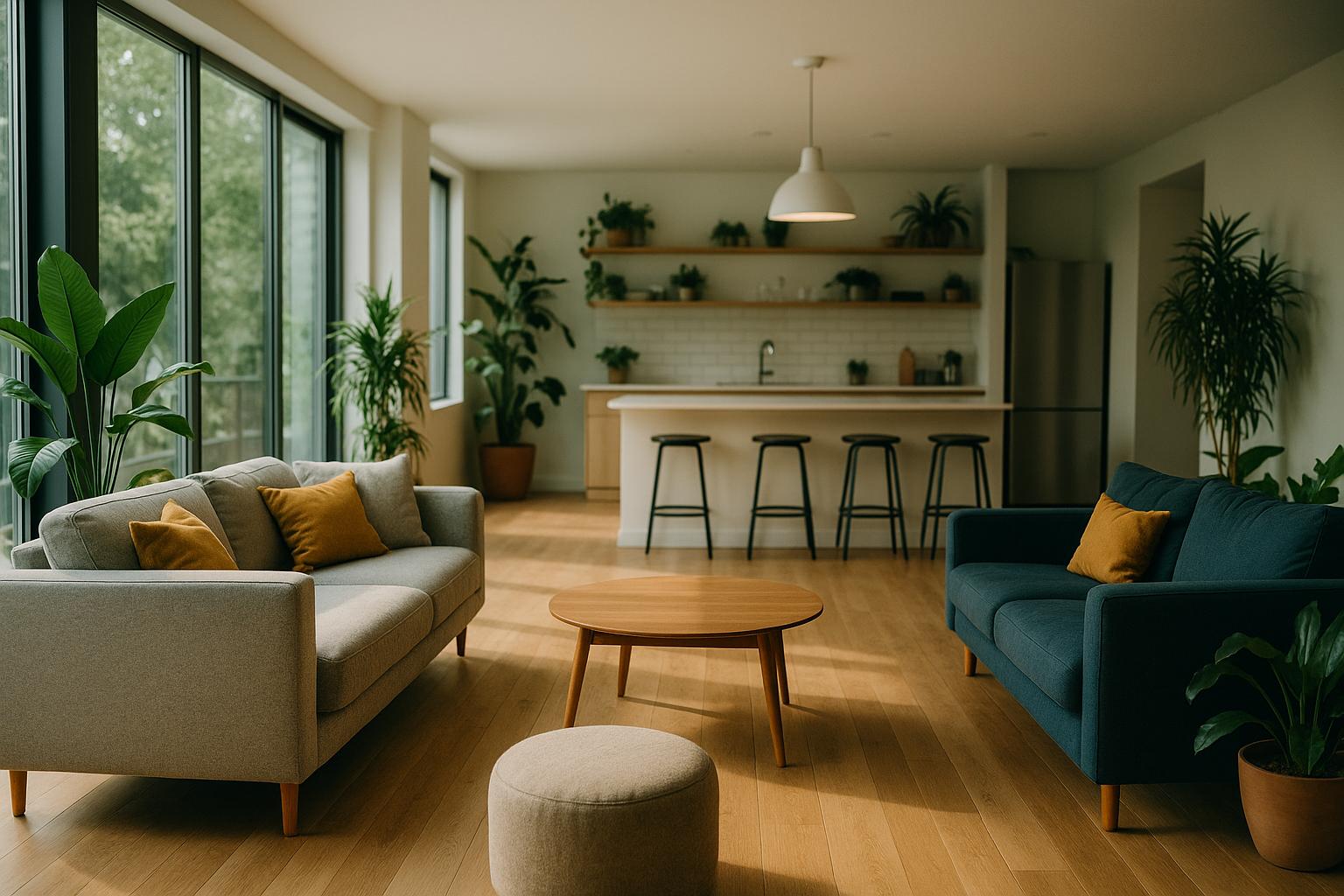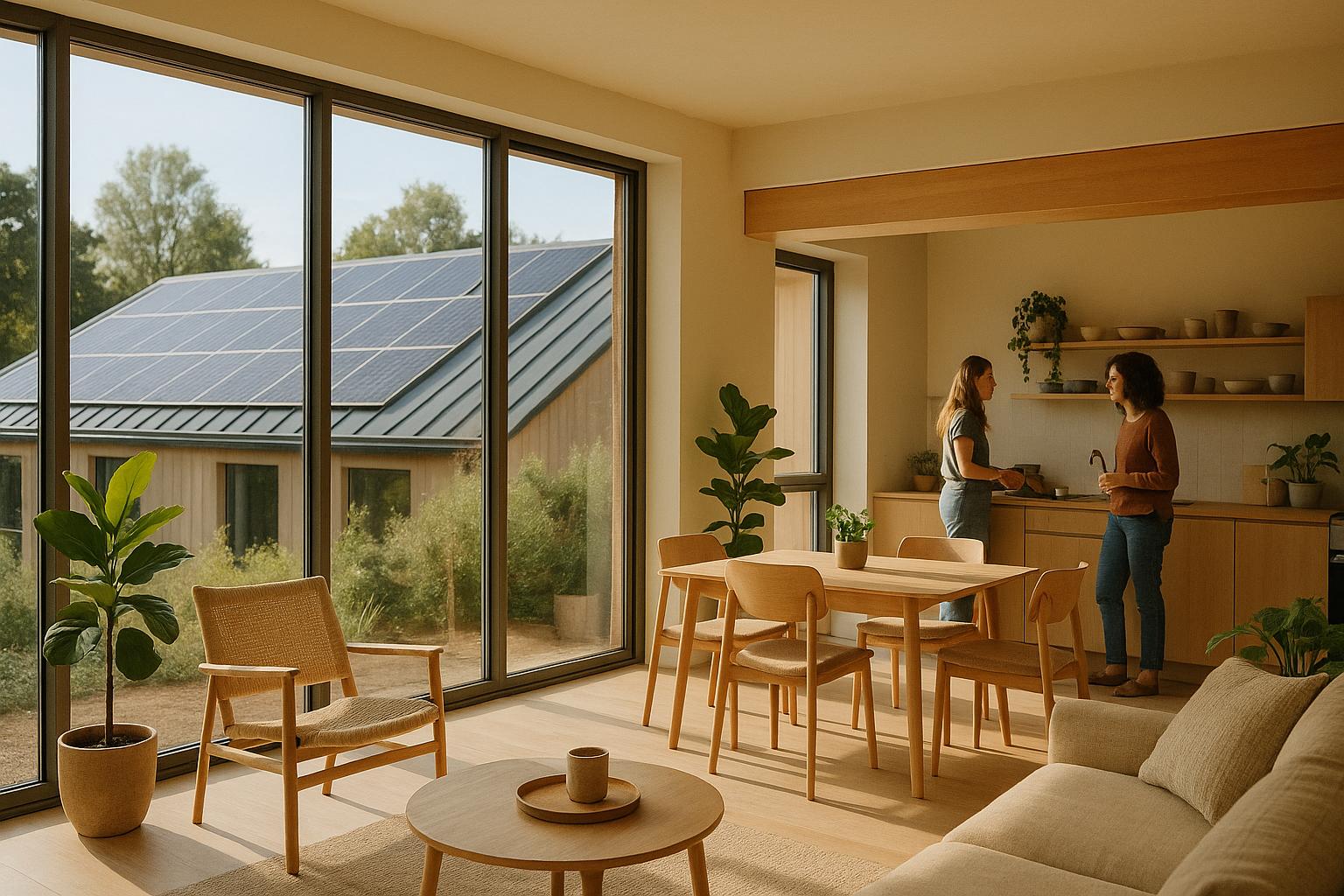Coliving is reshaping housing by addressing affordability, convenience, and community needs. With prices starting at $100/month, coliving offers all-inclusive living - covering utilities, Wi-Fi, and cleaning - while creating spaces that encourage social connections. Here’s what makes a great coliving property:
- Shared Spaces: Kitchens, lounges, and coworking areas designed for interaction and functionality, with 24/7 access and modular furniture for diverse activities.
- Flexible Leases: Short-term and month-to-month options, ideal for mobile professionals and students, with transparent pricing and easy extensions.
- High-Speed Internet & Utilities: Reliable Wi-Fi and bundled services to simplify budgeting and ensure uninterrupted work or leisure.
- Private Rooms: Comfortable personal spaces with soundproofing, storage, and modern tech for privacy and relaxation.
- Eco-Friendly Practices: Energy-efficient appliances, recycling programs, and smart tech for reducing waste and resource use.
These features cater to modern renters, combining convenience, affordability, and a sense of community.
1. Shared Community Spaces
Shared community spaces turn housing into more than just a place to live - they create vibrant communities where people connect and collaborate. Thoughtfully designed spaces become the heart of coliving, encouraging social interactions that make these living arrangements feel like home.
Community Engagement
Great coliving spaces cater to a variety of social needs. For instance, a spacious kitchen with a large island naturally draws people together for chats and shared meals. Cozy lounge areas with different seating options let residents choose between quiet one-on-one conversations or larger group hangouts.
Co-working areas have become a must in today’s remote work world. These zones should include good lighting, ergonomic chairs, and quiet spaces like phone booths or small meeting rooms for private calls or focused work.
Game rooms and entertainment spaces are another way to bring people together. Whether it’s a pool table, a stack of board games, or a comfy spot to watch TV, these areas encourage casual interactions that can grow into meaningful friendships. When these spaces are seamlessly connected to other common areas, they naturally invite residents to join in.
Flexibility and Accessibility
Modern community spaces need to work for everyone, no matter their schedule or lifestyle. 24/7 access is essential, especially for residents working across different time zones. These spaces should be just as welcoming for an early morning coffee chat as they are for a late-night study session.
Flexibility is key. Modular furniture makes it easy to transform spaces for different activities, like yoga classes or birthday celebrations. Moveable partitions or room dividers help create smaller, more private areas within larger rooms, giving residents options for how they use the space.
Shared storage for things like sports gear and games keeps everything organized and encourages communal use of recreational items. These thoughtful touches make community spaces more functional while staying true to coliving’s promise of convenience and affordability.
Balance of Privacy and Shared Living
A good community space strikes a balance between fostering interaction and respecting personal boundaries. Quiet corners and reading nooks let residents enjoy the shared areas without feeling obligated to socialize.
Acoustic design is crucial here. Using sound-absorbing materials and carefully placing noisier activities ensures that spaces don’t become overwhelming. For example, conversations shouldn’t have to compete with kitchen clatter or loud entertainment systems.
The transition from private rooms to shared areas also matters. Features like hallways with seating or small alcoves provide natural stopping points where residents can casually interact without feeling pressured to join larger groups.
When designed thoughtfully, these shared spaces become the backbone of a positive coliving experience. They create environments where people feel connected to a community while still having the space they need for themselves. Combined with flexible lease options, these spaces make coliving an appealing choice for modern lifestyles.
2. Flexible Lease Options
Traditional apartment leases often come with year-long commitments, which can feel restrictive in today’s fast-paced, mobile world. Coliving spaces, however, offer a refreshing alternative by providing lease terms that are designed to align with modern lifestyles and work patterns.
Flexibility and Accessibility
Coliving spaces stand out with their month-to-month agreements, allowing residents to adjust their stay as needed. This setup is especially appealing to remote workers and digital nomads who frequently move between locations.
For those seeking shorter stays - like professionals on temporary assignments, interns, or individuals exploring a new city - options ranging from one week to three months are available. These arrangements minimize the hassle of rigid contracts and eliminate the stress of hefty termination fees.
On top of that, many coliving spaces feature efficient booking systems that make it easy to extend a stay (when space allows) and offer transparent, all-inclusive pricing. This straightforward approach not only makes budgeting simpler but also reduces the chances of unexpected expenses, creating a more seamless living experience.
Community Engagement
The flexibility of these lease terms doesn’t just benefit individuals - it also enhances the sense of community. Without the pressure of long-term commitments, residents often feel more at ease and engaged during their stay. The result? A dynamic and ever-evolving community where new faces and fresh perspectives are constantly enriching the environment.
At the same time, flexible leases respect the need for personal space, striking a balance between shared living and individual privacy.
Balancing Privacy and Shared Living
Trial periods are another perk, allowing residents to experiment with different room setups and community dynamics before settling in. Seasonal flexibility is also a major advantage, catering to the changing needs of residents throughout the year. For instance, a student might thrive in a vibrant, social setting during the school year but prefer a quieter atmosphere during a summer internship. This adaptability ensures residents can find a setup that suits their shifting priorities.
Additionally, many coliving spaces offer cancellation policies that ease the financial strain in cases of unexpected events, such as job relocations or family emergencies. By doing so, these spaces transform housing into a supportive framework that accommodates both personal and professional growth.
When paired with essential amenities, flexible leasing creates a coliving model that truly aligns with the demands of today’s evolving lifestyles.
3. High-Speed Internet and All-Inclusive Utilities
Modern coliving thrives on two essentials: reliable internet and all-inclusive utilities. In a world where digital connectivity is a daily necessity, these features aren't just perks - they're foundational to the coliving experience. Whether you're tackling virtual meetings or brainstorming in shared spaces, seamless internet and simplified utilities make life easier and more enjoyable.
Dependable Technology for a Connected Lifestyle
High-speed internet is a non-negotiable for coliving spaces, especially for digital nomads and remote workers. Consistent, quality connectivity is often a challenge for those on the move, but coliving communities address this head-on. Many are designed with dedicated coworking areas equipped with high-capacity internet, ensuring multiple residents can work without interruptions.
Top-tier coliving properties treat reliable Wi-Fi as a core feature, recognizing how vital it is for modern living. Beyond internet access, having a solid technological infrastructure ensures these spaces can meet the demands of residents who rely on connectivity for work, entertainment, and everything in between.
Simplified Living with All-Inclusive Utilities
All-inclusive utility packages are a game-changer. By bundling services like electricity, water, gas, sewer, trash, high-speed Wi-Fi, and even cable TV into one predictable monthly bill, coliving spaces eliminate the hassle of juggling multiple providers and payments.
This setup not only simplifies budgeting but also saves residents from the headache of coordinating installations or dealing with unexpected charges. Everything is handled by the property, leaving you free to focus on what matters most.
Building Community Through Shared Resources
Shared utilities and internet do more than just cut costs - they also encourage interaction among residents. By pooling resources, coliving communities can offer premium amenities like cleaning services, in-unit laundry, coworking spaces, fitness centers, and even pools. These shared perks help create a sense of camaraderie while keeping individual expenses manageable.
In short, high-speed internet and all-inclusive utilities aren't just about convenience - they're about creating a seamless, connected, and community-driven way of living.
4. Private Personal Space
Coliving thrives on community and shared experiences, but let’s face it - everyone needs their own corner to recharge. The best coliving spaces know this and make sure residents have a private retreat where they can work, relax, and unwind. This focus on privacy works hand-in-hand with the communal perks that make coliving appealing in the first place.
Finding the Right Balance
Creating a balance between shared spaces and private rooms is key. Private rooms should be more than just a place to sleep - they should feel like a personal haven. Features like dedicated work areas, soundproof sleeping spaces, plenty of storage, and, ideally, private bathrooms make a big difference. Soundproofing, for example, ensures you can take calls or enjoy uninterrupted rest without outside noise creeping in. Even shared facilities can be designed thoughtfully to maintain a sense of personal space.
Smart Design for Comfort
Good design goes a long way in making private spaces feel functional and inviting. Flexible layouts, adjustable furniture, and smart storage solutions are game-changers. Think rooms that can easily shift from a work mode during the day to a cozy relaxation spot at night. Wider doorways, grab bars, and other accessibility features also make these spaces inclusive and practical for everyone.
Tech That Keeps Up
In today’s world, reliable tech is non-negotiable. Private rooms in coliving spaces should come equipped with independent climate controls, well-placed outlets, and USB charging stations. Many properties even go the extra mile by ensuring strong internet connectivity for video calls, streaming, or remote work. This tech-forward approach ensures private rooms are ready to meet the demands of modern living.
5. Eco-Friendly Practices
Sustainability has become a non-negotiable for modern renters. It's no longer just a nice-to-have - it’s a key factor influencing the appeal of coliving spaces. Millennials and Gen Z, in particular, are actively seeking housing options that align with their values, offering a greener lifestyle without compromising comfort.
Environmental Responsibility
Leading coliving properties are weaving eco-conscious practices into their operations, benefiting both the residents and the planet. Energy-efficient appliances, LED lighting, and programmable thermostats are just a few examples of how these spaces are cutting utility costs while reducing environmental impact. Many are even installing solar panels to tap into renewable energy sources.
Water conservation is another big focus. Features like low-flow showerheads, dual-flush toilets, and greywater recycling systems are helping to significantly lower water usage. Some properties take it a step further with smart water meters, enabling residents to track their consumption and quickly spot leaks.
Reducing waste is also a top priority. Recycling programs, composting initiatives, and bulk purchasing are becoming standard practices. Some properties even collaborate with local farms to turn food scraps into compost, creating a full-circle approach to waste management. These efforts not only reduce environmental impact but also foster a sense of shared responsibility among residents.
Community Engagement
Sustainability thrives when residents are involved. Community gardens are a great example - they provide fresh produce while also serving as a space for residents to connect, grow their own food, and learn about sustainable gardening. These gardens often evolve into vibrant gathering spots, strengthening the sense of community.
Shared resource programs - like tool libraries or communal appliances - help cut down on waste and expenses. At the same time, they promote a culture of sharing and collaboration.
Educational workshops on topics like zero-waste living and energy conservation are another way to empower residents. By understanding how their choices impact the environment, people are more likely to embrace greener habits, both within the coliving space and in their daily lives.
Technological Reliability
Smart technology is playing a crucial role in making sustainable living easier and more efficient. Automated lighting systems, for instance, adjust based on occupancy or natural light, reducing energy use without requiring constant attention. Similarly, smart thermostats learn residents' habits and optimize heating and cooling schedules to save energy.
Real-time energy monitoring systems are another game-changer. These systems track electricity, water, and gas use, providing residents with clear insights into their consumption. Some properties even use digital dashboards to encourage conservation through friendly competitions, making sustainability both fun and impactful.
Transportation is another area where tech is making a difference. Many coliving spaces now offer electric vehicle charging stations, partner with bike-sharing services, or use apps to coordinate carpools. Some even provide electric scooters or bikes, making it easier for residents to navigate their neighborhoods sustainably.
Ready?
The five features highlighted above form the foundation of modern coliving spaces, addressing the distinct needs of today’s renters. Shared community spaces foster meaningful connections, turning buildings into more than just places to live. Flexible lease options offer the freedom to adapt to ever-changing careers and lifestyles. High-speed internet and all-inclusive utilities simplify daily living, while private personal spaces provide a much-needed retreat. Lastly, eco-friendly practices align with the growing demand for sustainable living choices.
These features directly tackle challenges faced by renters across the U.S. For instance, young professionals frequently moving between cities benefit from the flexibility to relocate without the burden of long-term leases. Digital nomads rely on dependable internet to stay productive during video calls or while managing large file uploads. Remote workers need a balance of quiet, focused spaces and communal areas for social interaction. Meanwhile, environmentally conscious renters seek housing options that align with their values.
What makes these features so effective is how they complement one another. Shared spaces encourage community building, while flexible terms attract a diverse mix of residents. High-speed internet supports productivity, enabling everything from remote work to virtual events. Together, these elements create a living environment that is both functional and inviting.
For property operators, incorporating these essentials isn’t just about meeting renters’ expectations - it’s a smart business move. Communities designed with these features often enjoy higher occupancy rates, longer resident stays, and increased referrals. By prioritizing these elements, coliving spaces can create environments where both residents and operators thrive in today’s fast-evolving housing market.
FAQs
How do shared spaces in coliving properties help create a sense of community?
Shared spaces in coliving properties are at the heart of creating a vibrant community. Whether it’s the lounge, kitchen, or a coworking area, these spaces naturally bring people together. They’re perfect for striking up conversations, collaborating on projects, or simply enjoying a shared meal. Plus, they offer a unique chance to connect with individuals from all walks of life, cultivating an environment that feels open and welcoming.
These areas also encourage spontaneous interactions and serve as hubs for group activities, making it easier for residents to feel at home. For digital nomads, young professionals, and global citizens, these connections often become the highlight of their coliving experience, providing a sense of belonging that’s both comforting and enriching.
What are the advantages of flexible lease terms for residents in coliving spaces, especially those with active and changing lifestyles?
Flexible lease terms offer residents the ability to tailor their living situations to match their changing needs, all without being locked into lengthy commitments. This approach is particularly helpful for remote workers, digital nomads, or anyone navigating a transitional phase in life.
With shorter notice periods and adjustable agreements, residents can move or extend their stay with ease, avoiding added stress or financial strain. This adaptability makes coliving spaces an attractive option for those with unpredictable schedules or ever-changing lifestyles, blending convenience with a sense of ease.
What eco-friendly features should you look for in a coliving property, and how do they support sustainability?
Eco-Friendly Features in Coliving Spaces
Coliving properties with eco-friendly features are making strides toward sustainability by cutting down energy consumption, conserving water, and reducing waste. When considering a coliving space, keep an eye out for properties equipped with solar panels, energy-efficient appliances, rainwater harvesting systems, and green roofs. These elements help minimize the environmental footprint while maintaining modern comforts.
Additional sustainable features might include communal gardens, recycled or eco-conscious building materials, and waste management programs like composting or recycling initiatives. These efforts not only benefit the planet but also enhance the quality of life for residents.
By embracing sustainable practices, coliving spaces create a healthier, more socially conscious environment. They encourage a sense of shared responsibility, helping residents adopt more mindful habits and contribute to a cleaner, greener future.






